JAPANESE SPACE PROGRAM
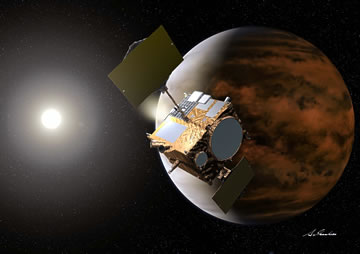
Venus climate orbiter The Japanese equivalent of NASA is the Japan Aerospace Exploration Agency (JAXA). Japan’s space development competitiveness has been ranked seventh in the world behind India and Canada. Its annual space budget of $2.5 billion is one fourteenth that of the United States and one half that of Europe.
Japan launched its first mini two-stage rocket in 1957. This is regarded as the beginning of the Japanese space program. Japan has two launch centers in Kyushu: one near Kagoshima and another on the southern island of Tanegashima.
The Japanese space program is helped by access to advanced technology produced at home and friendly relations with the United States but is hurt but tight budgets and limited popular support. The program has gotten a boost as result of competition from China and India — which have been making great advances is space even though they lack Japan’s advanced technology.
Two Japanese spacecraft swept up wind from Halley's Comet in the 1980s. In November 2005, a mini-robot vehicle sent to investigate the surface of an asteroid was lost in space after it was released from a spacecraft only 55 meters from the asteroid. The vehicle was only 10 centimeters long and weighed 600 grams. It was designed to sample rocks on the asteroid surface.
In May 2010, a Venus climate probe and five satellites, including the “space yacht” Ikaros, were launched on a single H-2A rocket from Kagoshima. The space yacht will sail through space with a square 14-meter-wide solar sail. The probe, named Akatsuki, travel 520 million kilometers to Venus to study the planet’s atmosphere.
In October 2008, the Japan Origami Association announced that it had created a special paper airplane made with a special heat-resistant, glass-coated paper that its makers said would allow it to survive reentry into the atmosphere from space and float to earth. They makers hope to release the plane from the International Space Station.
National spending for the space industry is around ¥7 trillion. This figures is slated to double to ¥15 trillion in 2020 according to a government plan.
Japan pumps about $500 million a year into the ISS but critics say the country has little to show for it. Japanese have carried a number of experiments on the ISS. The first experiment by JAXA at the ISS, which involved collecting space dust outside the station, was planned in 1994 and conducted in 2001. Since then, more than 50 other experiments have been carried out by JAXA at the ISS. However, Tetsuo Yokoyama, ISS program manager at the agency, admits the research program has yielded little of value. "No results worthy of special mention have been produced yet," Yokoyama said. One reason for the lack of fruitful results is the long processing period for experiments. For example, half of the 18 experiments conducted at Kibo in 2008 and 2009 had been approved more than 10 years prior to when they were carried out. [Source: Yomiuri Shimbun, June 16, 2011]
Websites and Resources
Good Websites and Sources: Japan Aerospace Exploration and Agency (JAXA) jaxa.jp ; JAXA International Space Station Page iss.jaxa.jp ; KIBO kibo.jaxa.jp/en ; Institute of Space and Astronautical Science isas.ac.jp ; Space Environment Information Service hirweb.nict.go.jp ; Astronomy Astronomy in Japan www2.gol.com/users/stever/jastro ; National Astronomical Observatory of Japan nao.ac.jp
Links in this Website: SCIENCE IN JAPAN Factsanddetails.com/Japan ; NOBEL PRIZES IN JAPAN Factsanddetails.com/Japan ; JAPANESE SPACE PROGRAM Factsanddetails.com/Japan ; TECHNOLOGY IN JAPAN Factsanddetails.com/Japan ; GADGETRY AND INVENTIONS IN JAPAN Factsanddetails.com/Japan ; ROBOTS IN JAPAN Factsanddetails.com/Japan ; SONY, TOYOTA AND HONDA ROBOTS Factsanddetails.com/Japan ; UNIVERSITIES IN JAPAN Factsanddetails.com/Japan ;
Good Websites and Sources on Science: Japan Science and Technology Agency jst.go.jp/EN ; MEXT, Ministry of Education, Culture, Sports, Science and Technology mext.go.jp/english ; Science Links Japan sciencelinks.jp ; Stanford University J-Guide to Science and Technology jguide.stanford.edu ;Japan Advanced Institute of Science of Technology jaist.ac.jp ; Japan Institute of Invention and Innovation jiii.or.jp/english ; Statistical Handbook of Japan Science and Technology Chapter stat.go.jp/english/data/handbook ; 2010 Edition stat.go.jp/english/data/nenkan ; News stat.go.jp ; Trends in Japan: Science and Technology web-japan.org/trends/science ; Book: “Japanese Science From the Inside” by Samuel Coleman (Routledge, 2000).
Science Museums National Museum of Nature and Science kahaku.go.jp/english ; Museum of Natural History Tohuku University dges.tohoku.ac.jp/museum ; Osaka Museum of Natural History mus-nh.city.osaka.jp ; National Science Museum (Ueno Park in Tokyo) kahaku.go.jp National Museum of Nature and Science and Technology Tokyotopia tokyotopia.com ; Research Centers: Tsukuba Science City Wikipedia Article Wikipedia ; Fujitsu Laboratories fujitsu.com/group/labs ; Hitachi Research Laboratories hitachi.com/rd/hrl ; Toshiba Research and Development Center toshiba.co.jp
Japanese Astronauts

Koichi Wakata
tests a flying carpet In July 2011, Japan became the third-placed nation in terms of how many days its astronauts have spent in space, behind Russia and the United States. According to data collected by the Japan Aerospace Exploration Agency, nine Japanese astronauts will have spent a combined total of 494 days in space as of Sunday, overtaking the 493-day total of 10 German astronauts. At that time Russia was be in first place with 20,760 days shared between 104 astronauts, while the United States will have sent 331 astronauts into space for a total of 14,786 days.
The nine Japanese astronauts include Toyohiro Akiyama, 69, who in 1990 became the first Japanese in space. Akiyama, then a TV reporter, traveled into space aboard a Soyuz spacecraft of the former Soviet Union. Some have brought along special spherical “noodles” that easier to swallow in zero-gravity than conventional noodles.
Japan ranked seventh on the list at the end of 2009, but has moved up thanks to ISS stays by Soichi Noguchi, 46; Naoko Yamazaki, 40; and Furukawa. Teruhisa Tsujino, a JAXA official in charge of international affairs, said, "China ranks 12th with 20 days spent in space, but that total could rise quickly as China has plans to build its own space station."
Japanese astronaut Soichi Noguchi was on the space shuttle Discovery flight in July 2005, the first shuttle flight in 2 ½ years. Noguchi participated in space walks in which repairs were made to tiles damaged during take off. Noguchi will spend six months on the International Space Station starting in November 2009. Koichi Wakata is also scheduled to spend several months on the ISS in 2009. It will be Wakata’s third time in space, more than any other Japanese. Noguchi and Wakata will carry out experiments on the module. Kibo
In March 2008, Japanese astronaut Takao Doi went into space aboard the Space Shuttle Endeavor and became the first Japanese to participate in a docking procedure when the space shuttle docked with the International Space Station (ISS). Doi’s primary mission was installing the four-meter-long experiment module for Japanese the Kibo laboratory onto the ISS using the shuttle’s robotic arm. In June 2008, on another space shuttle mission, the Kibo shortage facility was installed to the experiment module. Japanese astronaut Akihiko Hoshide was responsible for operating the bolts to join the sections at the early and latter stages of the process.
Daisuke Enomoto, a former executive with the troubled Internet company Livedoor, paid the $21 million space tourist fee to fly on a 10-day trip to the International Space Station aboard the Russian Soyuz capsule in September 2006 but was pulled from the three-person crew at the last minute and replaced with Dallas businesswoman Anousheh Ansari, reportedly because he had kidney stones. Space Adventures, the space tourism company, that arranges trips into space said the cancellation the flight due to medical reasons meant that Enomoto was not entitled to a refund of his $21 million. Enomto sued Space Adventures, saying the company was well aware of kidney stones when he signed up for the trip and Ansaro was given a spot because she had invested in Space Adventures.
Japanese astronaut Koichi Wakata was selected as the first Japanese astronaut to do an extended stay on the International Space Station. He was delivered to the space station by the space shuttle Discovery in March 2008 and stayed on the space station for three months. One of his first chores was operating the robotic arm, which he helped design, to check the Discovery for tile damage and install solar wind panels on the ISS. Other goals include cultivating cells that will develop into frog kidneys and monitoring how his body reacts to being weightless for extended periods of time.
In December 2009, Japanese astronaut Soichi Noguchi arrived at the International Space Station for a six month stay during which time was involved in scientific studies making use of the space environment, grew a space garden with mint, dandelions and other plants, and engaged in the instillation of the robotic arm on the KIBO laboratory. It was Noguchi’s second trip in space. Because he was staying for such a long time he got a private room in the ISS. In June 2010, Soichi Noguchi returned to earth after spending 163 days in space, a record for a Japanese astronaut. The previous record was 137 days by Kooichi Wakata.
In April 2010, Japan’s third female astronaut, Naoki Yamazaki, was launched into space on the space Shuttle Discovery. Serving as the person in charge of delivering cargo to the International Space Station, she had trained for 10 years for the mission and was the last Japanese astronaut to be carried by a U.S. Space Shuttle. She is Japan’s eighth astronaut and first Japanese mother in space (she has a daughter born in 2002). Among the experiments that she performed in space was one carried out at the request of her seven-year-old daughter: to see if soap bubbles can be colored in space.
Japan’s first female astronaut, Chiaki Muraki, made trips into space in 1994 and 1998.
Latest Japanese Astronauts
“Satoshi Furukawa spent 167 days in space on the ISS. This was the longest ever stay in space for a Japanese astronaut, breaking Soichi Noguchi's record of 163 days. On June 8, 2011, Furukawa blasted off from the Baikonur cosmodrome in Kazakhstan. As he orbited Earth in the ISS, Furukawa conducted scientific and medical experiments, using his knowledge as a doctor. Furukawa and the two astronauts from the United States and Russia were originally scheduled to return to Earth in mid-November, but their flight was delayed because a failed launch of a Soyuz craft in August held back the arrival of the crew to replace them aboard the ISS. [Source: Masae Honma, Yomiuri Shimbun, November 23, 2011]
“In November a Russian Soyuz space capsule carrying Furukawa and two other astronauts landed safely near Arkalyk, Kazakhstan. Furukawa's first words after returning from space were: "I'm fine. I can really feel Earth's gravity." Asked by reporters what he wants to do, Furukawa said, "I'd like to take a deep bath." furukawa is the third Japanese to stay on the ISS for an extended period, following Koichi Wakata, 48, and Noguchi, 46.
“In late 2013, Wakata is scheduled to make a space voyage on a Soyuz craft for a half-year mission on the ISS. He will be the first Japanese astronaut to serve as commander.
Akihiko Engages in Record Spacewalks
In July 2012, Akihiko Hoshide arrived fat the International Space Station or a four-month mission. Jiji Press reported: “This is 43-year-old Hoshide's second space flight, after his mission on the U.S. space shuttle Discovery in June 2008. He will be the fourth Japanese astronaut to stay for an extended period on the ISS, following Koichi Wakata, 48, Soichi Noguchi, 47, and Satoshi Furukawa, 48. Hoshide will conduct an experiment in growing killifish in a laboratory of the Japanese experimental module Kibo, which he hooked up with the ISS during the 2008 mission. He also will handle the experimental release of small satellites, including Japanese ones. [Source: Jiji Press, July 17, 2012]
“In late July Hoshide used a robotic arm to grab the Kounotori 3 cargo spacecraft, then docked it with the International Space Station, becoming the first Japanese astronaut to perform the task. In late August, he conducted a spacewalk outside the ISS to replace the complex's switchboard. He was the third Japanese to take a spacewalk. During his stay he took part in the docking of Japan's unmanned cargo vehicle H-2 Transfer Vehicle Kounotori-3, or HTV3, and the privately owned U.S. spacecraft Space X Dragon. The launch was originally scheduled for June but was postponed due to defects in the rocket. The crew will return to Earth on Nov. 12.
In 2012, Akihiko Hoshide completed a four-month mission to the International Space Station and set a new record for spacewalks by a Japanese astronaut. He returned to earth in a Russian Soyuz spacecraft with colleagues Yury Malenchenko from Russia and Sunita Williams that parachuted down safely on a plain in Kazakhstan after undocking from the ISS about three hours earlier and re-entering the atmosphere at an altitude of about 100 km over the Black Sea. [Source: Kyodo, November 20, 2012]
Kyodo reported: “Hoshide, 43, accomplished three spacewalks during his mission, which lasted for more than 120 days. His spacewalks for making repairs to the station totaled 21 hours and 23 minutes, surpassing the previous record of 20 hours and five minutes by Soichi Noguchi. His four-month stay in space was the second mission for Hoshide after his first in 2008. In the latest stay, he conducted experiments inside Japan's Kibo laboratory module — which he helped assemble on his first mission — including releasing small satellites into space and raising a school of killifish.
On the spacewalks by Hoshide and Suni Williams, NASA reported: “Flight Engineers Suni Williams and Aki Hoshide completed their second spacewalk in less than a week at 1:34 p.m. Sept. 5. They completed the installation of a Main Bus Switching Unit (MBSU) that was hampered last week by a possible misalignment and damaged threads where a bolt must be placed. They also installed a camera on the International Space Station’s robotic arm, Canadarm2. [Source: NASA, September 7, 2012]
Flight Engineer Joe Acaba operated the Canadarm2 and monitored the spacewalkers from inside the International Space Station. Hoshide rode the Canadarm2 attached to a portable foot restraint to the MBSU worksite. Williams' and Hoshide's spacewalk on August 30 lasted eight hours and 17 minutes making it the third longest in U.S. spaceflight history. It was originally scheduled for 6.5 hours before mission controllers and the astronauts struggled to install the MBSU.
Kibo
Kibo, which means “hope” in Japanese, is Japan’s first manned space facility. An attachment on the International Space Station, it has room for up to four astronauts to perform experiments for a long period of time. The project was launched in 1985 and endured delays, overruns and near cancellation under the Clinton administration to finally made to the ISS in 2008, 15 years behind the date it was originally supposed to attached to the space station.
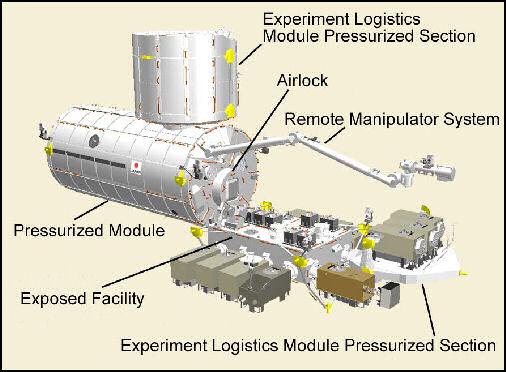
Among the experiments conducted on Kibo are ones controlling the crystallization process of silicon melting that can lead to the production of stable, homogeneous chip materials, which are known to be susceptible to liquid convection.
Kibo has three main parts: 1) the Experiment Logistics Module-Pressurized Section, installed on the first Kibo shuttle mission in March 2008; 2) the Pressurized Module for experiments, with an arm-like remote manipulator system, installed on the second Kibo shuttle mission in June 2008; and 3) the Experiment Logistics Module-Exposed Section, installed on the third Kibo shuttle mission
The Kibo laboratory was completed in July 2009. Japan spent $7.6 billion on it. Japan has spent a lot of money on the International Space Station and that doesn’t leave much money for other space programs.
H-2 Transfer Vehicle
In September 2009, Japan successfully launched the H-2 Transfer Vehicle (HTV), Japan’s first unmanned spacecraft, aboard an H-2 rocket and maneuvered it so it docked with the International Space Station (ISS). Japan hope the HTV will be the main supply vehicle for the ISS after the Space Shuttle is retired. The HTV is nicknamed the “Kounotori” (“White Stork”).
The development of the HTV began in 1996. Perhaps it most remarkable feature is its ability to be maneuvered to another space craft and dock with it using remote control. In its maiden voyage, it used the global positioning system to maneuver from five kilometers from the ISS to within 500 meters of it. From there it was carefully and gradually eased to the ISS by controllers on the ground. To prevent a crash the HTV could not proceed until it cleared several checks along the way. Crew members aboard the ISS had the power to stop the HTV if necessary.
The ISS moves at 7.7 kilometers per second 350 kilometers above the earth. Successfully docking the HTV with it one JAXA official said “is as difficult as threading the eye of a needle via remote control.” One of the HTV greatest attributes is that it is unmanned. If something happens to it there is no danger of loss of life and expensive safety systems and back systems used for astronauts do not have to be installed.
The cylindrical-shaped HTV is 9.8 meters long and has a diameter of 4.4 meters. It is comprised of three part:1) a pressurized section with a docking port where air pressure s kept at 1 atmosphere, allowing astronauts to enter; 2) an unpressurized mid section where items are stored in a drawer; and 3) the fuel tank an engine section with an area for electric power and telecommunications equipment.
The HTV2 (Kounotori 2) carries 5.3 tons of cargo, including food, equipment for experiments and drinking water. It delivers good to the ISS and then is loaded with waste. When it is ejected it is sent on path to burn up when re-entering the atmosphere. Japan is aiming to equip the HTV with a return capsule in five to six years.
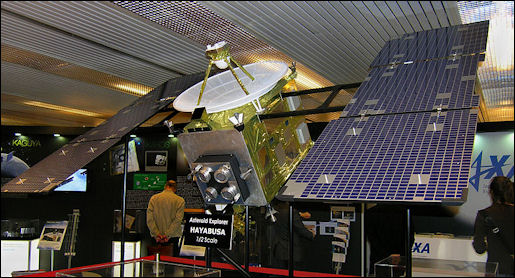
Hayabusa
Hayabusa Asteroid Probe
In June 2010, Hayabusa — a probe that landed in an asteroid and returned to Earth after a seven-year, 6-billion kilometers journey — landed in a desert in Australia. In 2005, Hayabusa landed on Itokawa asteroid, which is 294 x 535 x 209 meters in size and was 300 million kilometers from the Earth at time. It is the first space probe to return to Earth after traveling to a celestial body other than the moon.
Hayabusa means “peregrine falcon.” The probe was launched in May 2003 and traveled 40 times the distance between the Earth and the sun. It burned up on the return to Earth but released a six-kilogram pan-shaped capsule, which is about 30 centimeters in diameter and 15 centimeters high, that was fetched from the desert neat Woomera in southern Australia.
One of Hayabusa’s primary missions was to collect materials from the asteroid and bring t back to Earth. The probe failed to collect rock samples as was planned sand and other particles entered the capsule as result of the impact of the landing on the asteroid. A small amount of fine particles were found inside the probe’s collection chamber. These were thought to have come from the asteroid but at first scientists weren’t sure. Careful tests were conducted to determine if they did come from the asteroid.
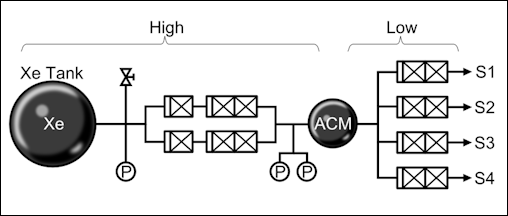
Hayabusa ion engine
In November 2010, JAXA announced that some of particles collected by Hayabusa were indeed from the asteroid. About 1,500 particles measuring from 0.001 millimeters to 0.01 millimeters in size were determined to have come from the asteroid. JAXA examined the particles and determined they were from asteroid because they were comprised of olivine and pyroxene — minerals observed by the probe when it landed on Itokawa. The discovery of the particles makes Hayabusa the first space probe to return to Earth with material from a celestial body other than the moon and a comet. The particles may be useful in understanding how the solar system formed. Unlike material on Earth which have been compressed and oxidized, geological material on asteroid is believed to have remained unchanged since the time the solar system formed.
It was quite an achievement hust to get Hayabusa back to Earth. After landing in Itokkawa, it suffered several crises. The main engines failed due to fuel leaks. For a while JAXA lost control of the probe and communication was lost. After seven weeks of scanning space for noise from the craft some weak signals were picked up and communication was restored. The probe was able to limp home using xenon-gas-powered ion engine developed by NEC. This engine is powered by ions rather than chemical jets of high-pressure gasses. Although not very powerful on Earth ion engines can run for a long time with little fuel. On the way back the to earth the three ion engines broke down but scientists were able to connect two of them using a spare diode in the control system, enabling them function as a single engine. At one point the probe was mainly being pushed by the sun’s rays which exert a force of less than one milligram per square meter.
There are plans to send a Hayabusa 2 probe on a mission to another asteroid, 1999JU3, which is said to be rich in life-building carbon compounds. The plan calls for a 2014 launch, 2018 asteroid landing and return to earth in 2020. The optimal time to reach the asteroid is 2014 and 2015 but budget cuts have meant that goal may difficult to reach. Among the main goals of this mission is to improve the sample collection devices used when it lands on the asteroid and improve the probe with more back up systems and more back up systems for the back up systems. In December 2010, the Japanese government approved ¥3 billion for Hayabusa 2 in the fiscal 2011 budget. It got only ¥30 million in 2010 after requesting ¥1.7 billion.
Hayabusa Films

-Schematic of ion engine Three feature-length Hayabusa have been made Twentieth Century Fox Japan, Toei Co. and Shochiku Co. They will be released one after another beginning in autumn. It is rare for movies on the same subject to be released so close together. Fox takes the lead with the opening of "Hayabusa" on Oct. 1 2011. Shochiku's "Okaeri Hayabusa" (Welcome back, Hayabusa) will be released in March 2010. Toei's "Hayabusa: Harukanaru Kikan" (Hayabusa: Returning home from faraway space) will also be released in 2012, on a date to be announced. [Source: Keiko Chino and Yasuko Onda, Yomiuri Shimbun, August 2011]
Keiko Chino and Yasuko Onda wrote in the Yomiuri Shimbun, “In Fox's depiction of people involved in the Hayabusa project, the story is told through the eyes of a researcher played by Yuko Takeuchi. The character is fictional, but the words and actions of real people including project leader Prof. Junichiro Kawaguchi are faithfully depicted. In Toei's version, a researcher modeled on Kawaguchi and played by Ken Watanabe is at the center of the story, which highlights researchers' passion and hard work in tackling the world's first asteroid-sampling project.”
“Shochiku uses 3-D to make its movie more family-oriented, with the addition of a human drama about an assistant engineer played by Tatsuya Fujiwara, who developed Hayabusa's engine, and his father. According to the Japan Aerospace Exploration Agency (JAXA), within just two months after Hayabusa's return, six companies approached the agency about making a film or TV drama about the spacecraft... JAXA set a condition for the filmmakers: Although their works are fiction, they must not change essential aspects of the truth or tell an unrealistic story. Radical departures from the facts-
Atatsuki Venus Probe

Hayabusa returning to earth In May 2010, a Venus climate probe was launched on a single H-2A rocket from Kagoshima. Named Akatsuki, the probe traveled 520 million kilometers to Venus, reaching it in December 2010. The plan was for it enter the planet’s orbit and conduct observations of its atmosphere. To do this it needed to fire its engines in a precise way at a specific time to slow down the probe and place it into an oval orbit around Venus, circling between 550 kilometers and 200,000 kilometers above the planet’s surface every 30 hours.
Unfortunately , the engine did not fire as it was supposed to and Akatsuki did not go into orbit around Venus. The engine was supposed to fire for at least nine minutes and 30 seconds but it only fired for two minutes and 23 seconds. The craft apparently suddenly lost stability, causing the engine to shut off and craft to enter the “safe hold mode” to regain stability. There was thought to be some kind of defect in the probe’s engine that caused to craft to lose stability. Specialists said it was likely high-temperature combustion cracked the probe’s thruster nozzle and fuel spurted from a crack, causing the probe to lose balance. It is thought the nozzle probably fell off. There are plans to try again in 2016 to place Akarsujki in Venus’s orbit. It will take that long for the probe to be in a good position near Venus again. The fortunate thing about the engine failure is that it left the probe with enough juice in the engine to have the power for the second attempt and the lose of the nozzle might make it easier to fly it straight and keep it stable.
JAXA’s Solar Spacecraft Recognized by Guinness Book of World Records
The Asahi Shimbun reported: “Ikaros, a Japanese probe launched in 2010, has been recognized by Guinness World Records as the first interplanetary solar sail spacecraft. It was developed by the Japan Aerospace Exploration Agency. Two separate cameras that were released from Ikaros to record the success of the unfurling of its solar sail were also recognized as the world's smallest satellites. [Source: Seiji Tanaka, Asahi Shimbun, December 30, 2012]
Ikaros was launched aboard an H-2A rocket in May 2010, together with Venus climate orbiter Akatsuki. Ikaros is fitted with a 14-meter by 14-meter "solar sail," the thickness of which is a tenth of the diameter of a human hair. The sail converts sunlight into propulsion. It is also equipped with ion-propulsion engines. The cylindrically shaped satellites are just 6 centimeters in diameter and 6.7 centimeters tall.
"The idea of the solar sail emerged a century ago, but no one had figured out a way to do it," said Osamu Mori, chief of the Ikaros demonstration team in JAXA. "(With our technology,) we have shown the rest of the world that it will not be able to catch up with Japan in this field for at least 10 years.”
Japanese Moon Program
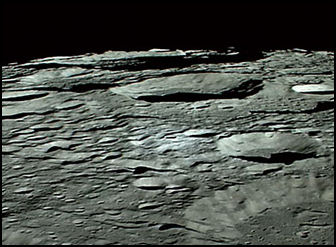
photo from Kaguya In September 2007, Japan launched its first probe to the moon. The probe — the Kaguya lunar explorer, comprised of a main satellite and two subsatellites — took extraordinary high definition pictures of the dark side of the moon and a full image of the earth from above the moon and scanned the surface with X-ray and infrared devices from about between 100 kilometers and 800 kilometers above the lunar surface. The probe was launched on H-2A rockets built by the private company, Mitsubishi Heavy Industries. The cost of the project was around $500 million.
The launch of the Japanese moon probe came a week before China launched its own lunar probe and was seen as escalation of Asia’s undeclared space race which also includes India who launched a lunar probe in April 2008.
Japan has plans for a spacecraft to land on the moon in the 2010s and release a lunar rover similar to the ones used by the United States on Mars. The Japanese craft, called Selene 2, will weigh about a ton and have three parts — the rover, a two-meter-high lander and a data-relay satellite that will orbit the moon.
One plan calls for a Japanese manned mission to the moon between 2025 and 2030. Japan has hopes of mining materials for fusion reactors on the moon and setting up an observatory there. Shimizu Corp., a large Japanese construction company, has a team researching the construction of a base on the moon. It has developed technology for manufacturing concrete on the lunar surface and building solar-powered satellite power plant.
Future Space Projects in Japan
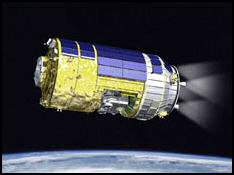
HTV H-11 Transfer Vehicle Japan is experimenting with prototypes of a reusable space capsule and a delta-wing space shuttle. Japanese scientists are working on a solar sail used to propel spaceships using sunlight.
The Japanese space agency is developing an arrow-shaped plane designed to be a successor to the Concorde. The plane travels twice the speed of sound and was tested over the Australian outback in 2005. In its first test in 2003 the plane prematurely was released from its rocket booster and crashed in the desert.
Japanese-designed H-2 Transfer Vehicle (HTV) may take on a role transporting goods to the International Space Station when the U.S. space shuttle program is scheduled to end in 2010. The HTV is 10 meters long and 4.4 metes in diameter and can carry up to six tons of goods. It is unmanned and is designed do be launched from a rocket and maneuvered to the space station by remote control and grabbed with the robotic arm. A test launch of the HTV will take place in the autumn of 2009.
In 2010, Japan plans to loft into space a 2.1-meter-long probe to Venus that will study the climate there. Japan and Russia have discussed conducting joint missions to Mars that would involve sending a probe to one of the Martian moons to collect soil and bring it back to earth in what would be the first round trip journey to Mars or one its moons. A Japanese mission to put a satellite in orbit around Mars came close to succeeding but failed.
Space Age Advances and Research in Japan
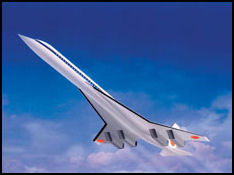
proposed
hypersonic plane Japan’s first nuclear reactor, in Tokaimura, Ibaraki Prefecture, went critical in 1957.
The Subaru telescope at the top of Mauna Kea in Hawaii is Japan's contribution to high-level astronomy research. Unlike other modern telescopes, which use sophisticated arrangements of multiple mirrors, Subaru has a single mirror that is 8.3 meters wide. Costing $400 million, the Subaru telescope broke resolution records for ground-based telescopes by seeing the equivalent of selling a basketball court from 180 miles away. Some if its images are arguably better than those of the Hubble telescope. Subaru is not a reference to the car company. Subaru is the Japanese name for the Pleiades.
The world smoothest mirror was produced in 2008 by Osaka University and the Riken Research Institute. The mirror is so smooth that if it were increased to 400 kilometers in size the maximum surface irregularity would be only 2 millimeters tall. The mirror is designed to be be used to focus x-ray, free-electron laser beams.
In May 2009, Japanese scientists made the first observation of monster galaxies in a group. The discovery was made by researchers at the National Astronomical Observatory, Tokyo University using the ASTE radio telescope in Chile.
In May 2010, scientists at the University of Tokyo said they found the world’s most distant galaxy cluster — 9.6 billion light years away. The discovery was made in the constellation Cetus using Europe’s orbiting X-ray observatory and the Subaru telescope in Hawaii. The previous record was a galaxy cluster 9.2 billion light years away.
Construction Firm Aims at Space Elevator in 2050
In February 2012, the Yomiuri Shimbun reported: “It may be possible to travel to space in an elevator as early as 2050, a major construction company has announced. Obayashi Corp., headquartered in Tokyo, unveiled a project to build a gigantic elevator that would transport passengers to a station 36,000 kilometers above the Earth. For the envisaged project, the company would utilize carbon nanotubes, which are 20 times stronger than steel, to produce cables for the space elevator. [Source: The Yomiuri Shimbun, February 22, 2012]
“The idea of space elevators has been described in several science-fiction novels. Obayashi, however, believes it is possible to construct one in the real world thanks to carbon nanotubes, which were invented in the 1990s, the company said.Some other organizations have also been studying the development of space elevators, such as the U.S. National Aeronautics and Space Administration.
“In Obayashi's project, a cable would be stretched up to 96,000 kilometers, or about one-fourth of the distance between the Earth and the moon. One end of the cable would be anchored at a spaceport on the ground, while the other would be fitted with a counterweight. The terminal station would house laboratories and living space. The car could carry up to 30 people to the station at 200 kilometers per hour, which would mean a 7-1/2 day trip to reach the station. Magnetic linear motors are one possible means of propulsion for the car, according to Obayashi.
“Solar power generation facilities would also be set up around the terminal station to transmit power to the ground, the company added. Whether carbon nanotubes can be mass-produced economically enough and whether various organizations from around the world can work together are two key issues facing the development of the space elevator, according to the company."At this moment, we cannot estimate the cost for the project," an Obayashi official said. "However, we'll try to make steady progress so that it won't end just up as simply a dream.”
Eclipses and Amateur Astronomers in Japan
The longest total eclipse of the 21st century swept just south of the main islands of Japan in July 2009. On some small islands between Kyushu and Okinawa the total eclipse was visible. Some people paid big money to reach these islands by ship and camp out, only to have clouds and rains block the view of the eclipse. Those that paid more to watch the eclipse from a cruise liner out at sea experienced the eclipse in its full glory. From parts of Kyushu, the eclipse was 95 percent complete. In Tokyo the sun cover was about 75 percent.
The eclipse was the first in Japan in 46 years and the longest ever over Japan in historical times. It lasted for about six and half minutes around the Ogasawara islands, the longest time for an eclipse anywhere on the planet this century. On the islands south of Kyushu, where clouds and rainy blocked the view of the eclipse day turned to night for six minutes.
On May 21, 2012, an annular solar eclipse was observed across Japan in the morning from the southern Tohoku region to the Pacific side of the southern Kyushu region. The sun resembles a golden ring during an annular eclipse, as a thin halo of sunlight peeks out from around the moon passing in front of it. Gatherings and other events to observe the celestial phenomenon were held across the nation, with travel agencies selling special package tours. It was the first time in 932 years that an annular solar eclipse was visible over such a wide area. The next time this will occur is 2312.
In July 2009, 61-year-old amateur Japanese astronomer Koichi Itagaki discovered his 50th supernova in just nine years, according to Oriental Astronomical Association. He is the top super nova watcher in Japan and No. 9 in the world. He uses 60-centimeter and 50-centimeter reflecting telescope at his five-meter-tall dome-shaped observatory at the foot of the Zao mountains in Yamagata Prefecture.
When looking for super novas Itagaki hooks up his telescopes to six computers and compares current images of stars with images of the same area taken several years before. He then scans through the computer looking for new or brighter stars — possible supernovas — spending about five seconds on each image. He does this every clear night and goes through about 1,500 images a night, with his telescopes aimed at galaxies because that is where stars are at their highest concentrations.
Image Sources: JAXA, Hayabusa from Wiki Commons
Text Sources: New York Times, Washington Post, Los Angeles Times, Daily Yomiuri, Times of London, Japan National Tourist Organization (JNTO), National Geographic, The New Yorker, Time, Newsweek, Reuters, AP, Lonely Planet Guides, Compton’s Encyclopedia and various books and other publications.
Last updated January 2013
